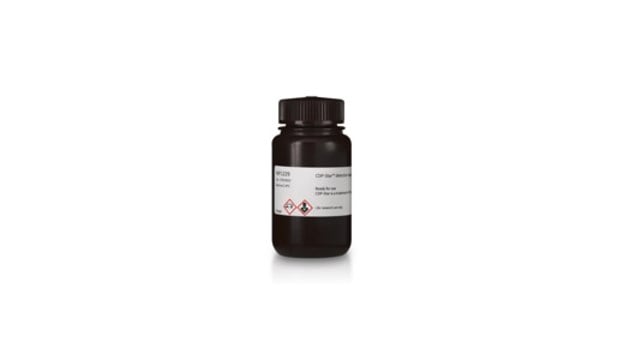12041677001
Roche
CDP-Star®, ready-to-use
>98%, solution, suitable for dot blot, suitable for Northern blotting, suitable for Southern blotting
About This Item
Recommended Products
description
Disodium 2-chloro-5-(4-methoxyspiro {1,2-dioxetane-3,2′-(5′-chloro)tricyclo[3.3.1.13,7 ]decan}-4-yl)-1-phenyl phosphate
Quality Level
Assay
>98%
form
solution
packaging
bottle of 2 × 50 mL ([0.25 mM])
manufacturer/tradename
Roche
technique(s)
Northern blotting: suitable
Southern blotting: suitable
dot blot: suitable
storage temp.
2-8°C
Publishing
Application
- Southern blot
- Northern blot
- Dot blot
- Colony and plaque hybridization
- Gel shift assays
- Southern blot
- Northern blot
- Dot blot
- Colony and plaque hybridization
- Gel shift assays
- Chemiluminescent detection.
Features and Benefits
0.25 mM solution (0.124 mg/ml), ready-to-use, colorless solution
- Save time with a fast, ultra-sensitive substrate.
- Easily strip and reprobe membranes.
- Take multiple exposures of up to two days for each experiment.
Preparation Note
Maleic Acid Buffer: 15 to 25 °C, stable
Detection Buffer: 15 to 25 °C, stable
Blocking Solution: always prepare freshly
Antibody Solution: 2 to 8 °C
Other Notes
- First exposure to X-ray film should be 5-15 minutes. Examine film and then determine other exposure times based on initial result.
- No preincubation step required.
- Apply substrate quickly to avoid gray shadows from substrate drops and drying of membrane (leads to uneven, high background).
- Do not use plastic wrap to cover blot; use hybridization bags, acetate sheet protectors, or two sheets of transparent film.
- Exposure times are shorter than with CSPD.
- Do not use nitrocellulose membranes.
Legal Information
Storage Class Code
12 - Non Combustible Liquids
WGK
nwg
Flash Point(F)
does not flash
Flash Point(C)
does not flash
Certificates of Analysis (COA)
Search for Certificates of Analysis (COA) by entering the products Lot/Batch Number. Lot and Batch Numbers can be found on a product’s label following the words ‘Lot’ or ‘Batch’.
Already Own This Product?
Find documentation for the products that you have recently purchased in the Document Library.
Customers Also Viewed
Our team of scientists has experience in all areas of research including Life Science, Material Science, Chemical Synthesis, Chromatography, Analytical and many others.
Contact Technical Service




![CSPD ready-to-use Disodium 3-(4-methoxyspiro {1,2-dioxetane-3,2′-(5′-chloro)tricyclo [3.3.1.13,7]decan}-4-yl)phenyl phosphate](/deepweb/assets/sigmaaldrich/product/images/352/091/ef743cea-ccd8-44f1-8f3b-dec5a1e4f5d1/640/ef743cea-ccd8-44f1-8f3b-dec5a1e4f5d1.jpg)




